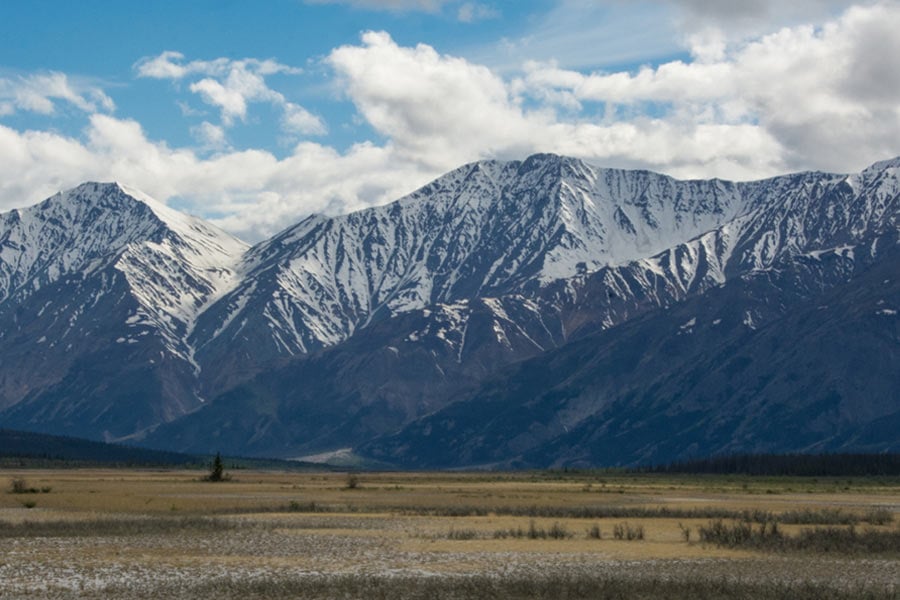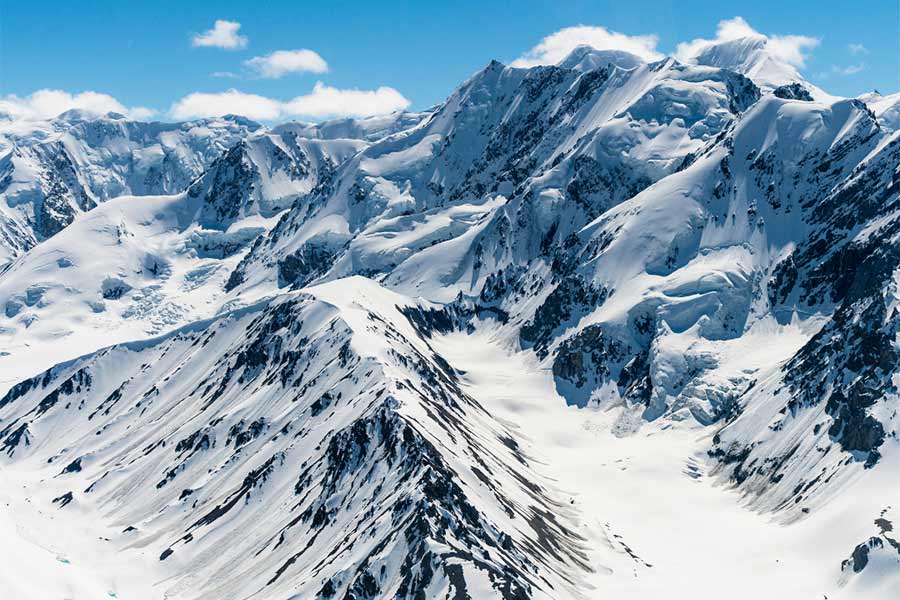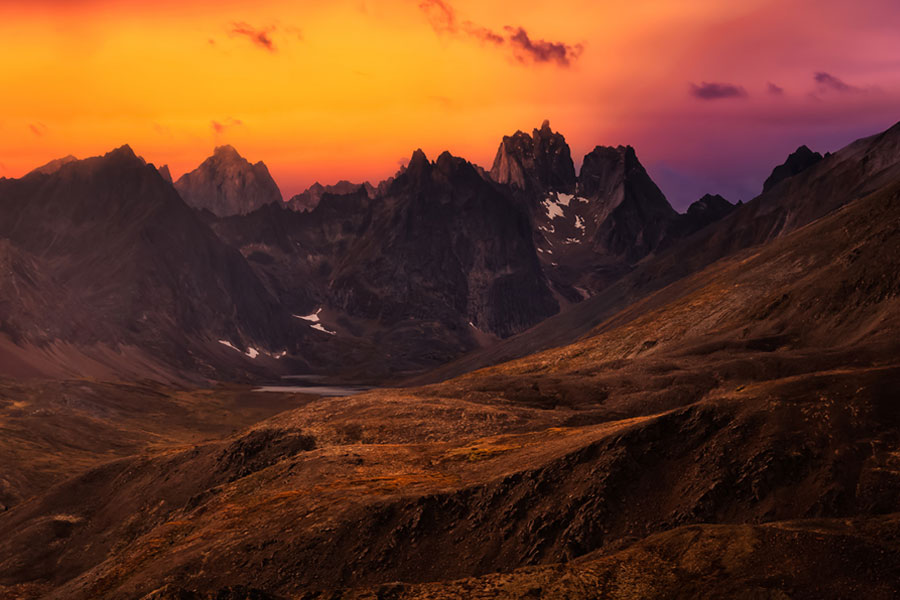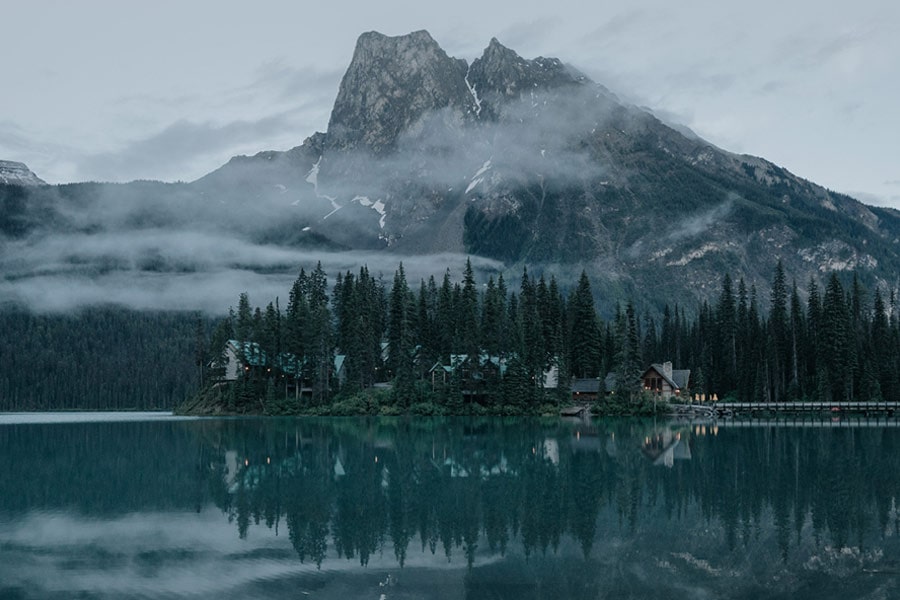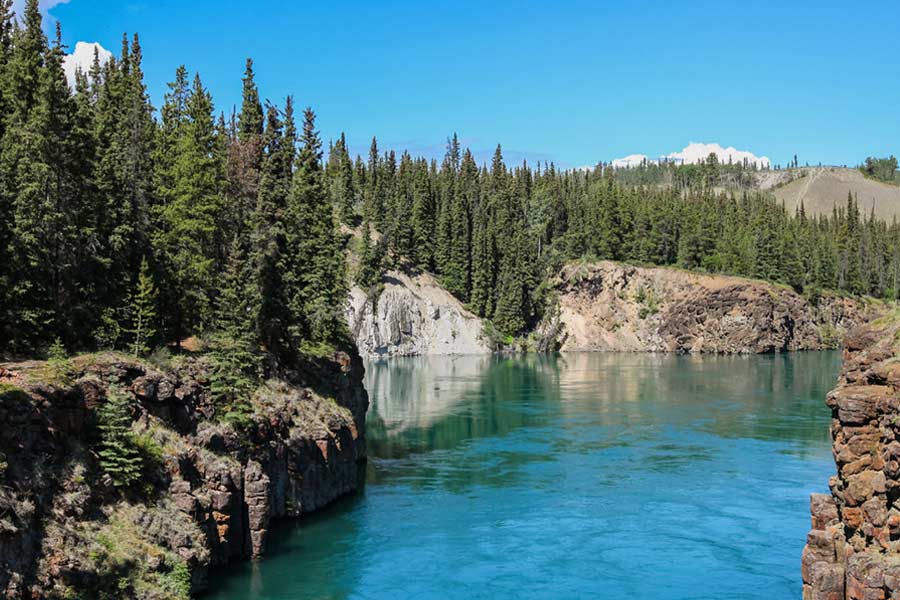Imagine waking up and opening your tent flap to see a crystal clear lake with a backdrop of snowcapped mountain ranges. Sound like a dream? It's not. It's called Yukon and it's located in northwest Canada.
With international travel currently harder to pull off than it's worth, it's good to know that a trip to Yukon is no more complex than a road trip or domestic flight.
Not convinced northwest Canada is for you? These top 5 tourist destinations in Yukon will change your mind.
Dichotomy of Yukon
Covering about 483,000 km² - about three times the size of England - Yukon is a mosaic of environmental ecosystems.
Home to the largest non-polar icefields in the world, the majority of the territory is considered a subarctic plateau intermingled with stunning mountain ranges, pristine rivers and lakes, and the coastal plain sweeping up to the Beaufort Sea.
Explore the breathtaking scenery of the lowlands on foot with one of the many hiking trails. Or, if you're more adventurous, you could scale one of the many mountains.
If water sports are your thing, there's no shortage of options with 30 major lakes and about 70 rivers. You can kayak, canoe, raft, boat, fish or swim - depending on your tolerance for the cold - against stunning backdrops.
Yukon's wonderfully varied topography makes it an ideal spot for a holiday centred on the great outdoors and adventure - something we could all use after being cooped up in lockdown for so long!
History
Exploring Yukon today, it's not hard to imagine what the Ice Age would have been like. With the vast icefields, glaciers and caribou wondering about, Yukon's history is carved into the scenery.
Historians believe it was during the Ice Age that Yukon's First Nations people arrived. Researchers believe humans have been established innings Northern Yukon for up to 20,000 years.
By the 1700s, a few thousand years later, First Nations people had established significant fur trade with Asia, Europe and North America. In 1840, Hudson's Bay Company explorers entered the region, eventually building trading posts to varying degrees of success.
Prospectors flocked to the region in the 1890s after rich gold deposits were discovered in Bonanza Creek, connected to the Klondike River. The gold rush transformed the nearby Dawson settlement into a bustling city with new railways and roads connecting it to other major settlements.
This rapid growth led the Canadian Parliament to declare the region a territory in 1898. However, the gold boom did not last and the population dwindled.
Yukon's political position has changed much over the years. Originally governed by a Federal government-appointed commissioner, the territory now has an elected premier.
Politics in the 20th and 21st centuries have been characterized by discussions with First Nations people relating to land claims and self-governance, for which an agreement was reached in 1990. Today, 11 of the 14 First Nations Groups are self-governed.
Getting Around Yukon
There's nothing worse than going on a holiday only to discover your destination is difficult to get around. This is often especially true of adventure holiday destinations.
Yukon, thankfully, is an exception to this rule. Despite its enormous size and relatively remote location, getting around Yukon is surprisingly easy if you have a vehicle.
Location
Lodged between Canada's Northwest Territories and Alaska, Yukon sits at Canada's most western point - the Yukon/Alaskan border.
Remote and sparsely populated, planning a trip to Yukon will require having a clear idea of what you want to do while you're there. If climbing the snow-capped peaks of the mountains or visiting the famed Emerald Lake is on your agenda, the south is where you want to go. However, if you're a history buff or a keen gold prospector, you'll want to head further north to Dawson.
In terms of travelling to Yukon, Whitehorse, in Yukon’s south, has an international airport. Otherwise, you could drive north from British Columbia or east from Alaska.
Transportation
In terms of getting around Yukon, it's best to have a vehicle. There are plenty of vehicle rental options available. Just ensure you're insured.
Alternatively, Yukon has a ride-sharing service. Great for short trips to events or popular spots, Yukon RideShare is a fun way to meet locals or other vacationers while saving money and the environment.
1. Kluane National Park
Nestled in Yukon's mountainous southwest region, Kluane National Park attracts travellers from all over the world - and for good reason.
Not only is the park home to the largest non-Polar icefield in the world, but it boats Canada's highest mountain - Mt. Logan. All this, combined with spectacular scenery and a range of outdoor activities and camping spots, makes for an adventure holiday to remember!
Kluane National Park has a range of hiking trails catering to all experience levels. From the 10-minute wheelchair-accessible Kokanee boardwalk following Kathleen Lake, to the Cottonwood trail - a 6-day loop traversing two alpine passes - there is truly a trail for everyone.
Compared to other parts of Yukon, parts of Kluane National Park are well set up for individuals with mobility disabilities.
Would you like to raft past a glacier? If so, check out the Alsek River! Flowing 250km through the wilderness, a rafting trip can be anywhere between 3 and 14 days long.
If you prefer the comforts of solid ground, mountain biking could be more your style. The park's many old mining trails are ideal mountain bike terrain.
It's not fun to talk about, but extreme sports such as these can be dangerous. Before travel, research the likely weather conditions, pack the appropriate gear and insure yourself in case anything goes wrong.
Alternatively, slow down on a spring day and you might spot a Peregrin falcon or a bald eagle at the Park bird sanctuary. With more than 150 bird species in the area, Kluane is a birdwatcher's paradise.
If you relish the cold, winter in Kluane truly is a wonderland. Filled with endless opportunities for adventure from cross-country skiing, ice-fishing, snowmobiling, to dog-sledding. February and March are the best times for fun in the snow.
Kluane National Park Flightseeing
The best vantage point from which to take in Kluane's spectacular scenery is the sky - how else would you be able to fully appreciate the diversity of landscape?
There is a range of companies that offer flightseeing tours over Kluane, including touchdown tours into ice fields that let travellers explore for a few hours or days without having to make the difficult hike in.
Kathleen Lake
If rugged wilderness adventures don't appeal to you, but you still want to soak up the views of the mountains, Kathleen Lake is for you.
Less than two hours from Whitehorse, the shores of Mät’àtäna Män - also known as Kathleen Lake - offer accessible camping spots with a spectacular mountain range as a backdrop.
Experience the midnight sun in summer at one of the 38 camping sites with access to all the amenities, or 'glamp' in an 'oTENTik' - a cross between a tent and a cabin that takes the hassle out of camping.
Put your feet up and read a book, make the most of one of the nearby hiking trails, or kayak on the crystal waters of the lake - the choice is yours!
2. Mount Logan
Standing at 5959 metres tall, Mt. Logan is the second highest peak in North America - second only to Denali. Not to be outdone, Mt. Logan boasts the largest base circumference of any non-volcanic mountain in the world. It's also home to the Logan and Hubbard glaciers.
While the idea of scaling this mountain might seem fun, actually doing so is best left to advanced mountaineers. Most expeditions up the mountain take about three weeks in total and require a charter flight from the small city of Haines Junction to base camp. Mountaineering guides also come highly recommended.
There are two main routes up the mountain. The Kings Trench route is generally considered the easiest of the two - if skiing up a glacier can be considered 'easy'.
Alternatively, the East Ridge route involves a 4000-metre wall climb.
Mountaineers who do attempt to scale the mountain are rewarded with spectacular views of scenery largely untouched by humankind.
The weather is volatile, so the best time of year to climb Mt Logan is between May and August. While the temperature at the base of the mountain is likely to be 20ºC during this time, it drops to below freezing by the 5000-metre mark.
If mountains are your thing, there are plenty of others to choose from in Yukon. Mount Saint Elias at 5489 metres, Mount Luciana at 5260 metres and Kings Peak at 5173 metres do not lag far behind the lofty Mount Logan in terms of height or scenery.
Regardless of which mountain you choose to climb, you must do your homework before your go. Get in touch with a mountaineering guide company and find out what you need to do to prepare. If you have any health conditions, book an appointment with your GP.
Mount Logan Lodge
If climbing Mt Logan seems like a tall order, you could take in the spectacular views from a cozy room at Mount Logan Lodge instead.
Nestled amongst the trees, the quaint log house is located 9km from Haines Junction. Offering ski-to-door access (including a ski equipment rental service), gourmet breakfast and a hot tub, the lodge is a civilized alternative to the volatile peaks of Mt Logan.
There are also plenty of opportunities for hiking, fishing, sea kayaking, snowmobiling and dog-sledding all available on-demand at the property.
3. Tombstone Territorial Park
If the wilderness is calling to you, it might be Tombstone Territorial Park on the line.
With few established trails and the nearest food and gas more than 100km away in Dawson, Tombstone Territorial Park has earned the adjective 'remote'.
What you lose in amenities, you gain in peace, quiet and truly majestic scenery. Truly majestic.
Tombstone Mountain Campground and the nearby Interpretive Centre offer the most amenities. However, if you're keen to experience the scenery and you're prepared, you can't go wrong with backcountry camping.
As mentioned, there's not much in the way of established hiking trails. If hiking is on your agenda, it's best to be prepared. The few established trails may seem easy at first glance. Do not be fooled.
The Beaver Pond Interpretive Trail and Edge of the Arctic Interpretive Trail are exceptions to this rule. While other trails, including the beautiful Hart River Winter Road and North Klondike Trail, may be listed as 'moderate', volatile weather can make things hard.
Due to this weather volatility and other factors, spending larger amounts of time in places like Tombstone Territorial Park can be dangerous. Preparation, including a comprehensive travel insurance plan, is key.
However, don't let the challenge put you off. In Spring, Summer and Autumn, the park boasts extraordinary colours. The scenery is dotted with wildflowers, shrubs and birds in the Summer, only to be transformed into rich hues of orange in Autumn.
Tombstone Territorial Park Weather
Tombstone Territorial Park facilities are open from late May to September. You can still visit the park outside of these months - there's nothing better than a clear winter day in the snow. However, it is strongly advised to check the road and weather conditions before you travel.
As mentioned, the weather at Tombstone Territorial Park can be volatile, even in the warmer months. Ensure you have enough food, water and gas, as well as the appropriate clothing and equipment for the activities you plan to do.
4. Emerald Lake
Located in Yukon's South, Emerald Lake is named for its dazzling hues of green, blue and aquamarine water. On a sunny day, the colours are so intense that it looks photoshopped. However, there's no photoshop wizardry at play here - the striking hues are a reflection of marl deposits at the bottom of the lake.
Aside from soaking in the views and magnificent colours, there are plenty of reasons to make the trip to Emerald Lake.
Hike the 19km around the lake. Or, if you haven't got time, walk a smaller section of it. Brave the cold and swim! Or admire the water from afar over a picnic. If you're looking for the perfect photo-op, the lake is usually serene and ideal for photography.
Emerald Lake is definitely an attraction you can't miss on your trip to Yukon!
5. Miles Canyon
Just 10 minutes from Whitehorse, you can observe the result of lava flow over a pre-glacial landscape. To be fair, the lava flow dried up about 9 million years ago. The result, however, is still there today. It's known as Miles Canyon. Today, striking turquoise water runs where the lava would have flowed.
While the view alone warrants the short trip from Whitehorse by car or foot, there's also a network of hiking trails around the canyon that are worth doing if you have time. You can do the full 15km loop, which is rated as 'moderate' in terms of difficulty, or carve out a shorter route for yourself.
The best time to visit is between May and October.
Pack Your Bags and Head to Yukon Today!
The wilderness of Yukon is calling. Will you answer? Start planning your trip today!
Before you book your flights, campsite or rental RV, make sure you take out a travel insurance policy. Insurdinary has the best travel coverage out there - get in touch with us today.


